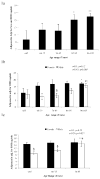Adiponectin levels and genotype: a potential regulator of life span in humans
- PMID: 18511746
- PMCID: PMC4507412
- DOI: 10.1093/gerona/63.5.447
Adiponectin levels and genotype: a potential regulator of life span in humans
Abstract
Although caloric restriction in numerous models extends life, longevity in humans is suggested to be limited by the increased prevalence of obesity. Adiponectin, a fat-derived peptide, has a protective role against age-related disease, and thus is an excellent candidate gene for longevity. We studied adiponectin levels in centenarians (n = 118), their offspring (n = 228), and unrelated participants <95 (n = 78). Adiponectin levels were significantly greater in participants older than 95 years (p =.01), an effect that was independent of sex and body mass index (BMI). Adiponectin levels in the offspring were higher (following adjustment for age, sex, and BMI) compared to controls (p =.02), suggesting that inherited factors play a role in determining adiponectin levels. Over-representation of two common variants in Adiponectin gene (ADIPOQ) in male long-lived individuals combined with their independent association with elevated plasma adiponectin levels (in men and women) suggests that their presence may promote increased life span through the regulation of adiponectin production and/or secretion.
Figures

References
-
- Perls T, Kunkel LM, Puca AA. The genetics of exceptional human longevity. J Mol Neurosci. 2002;19:233–238. - PubMed
-
- Atzmon G, Schechter C, Greiner W, et al. Clinical phenotype of families with longevity. J Am Geriatr Soc. 2004;52:274–277. - PubMed
-
- Barbieri M, Rizzo MR, Manzella D, Paolisso G. Age-related insulin resistance: is it an obligatory finding? The lesson from healthy centenarians. Diabetes Metab Res Rev. 2001;17:19–26. - PubMed
-
- Shimada K, Miyazaki T, Daida H. Adiponectin and atherosclerotic disease. Clin Chim Acta. 2004;344:1–12. - PubMed
Publication types
MeSH terms
Substances
Grants and funding
LinkOut - more resources
Full Text Sources
Molecular Biology Databases
Miscellaneous

